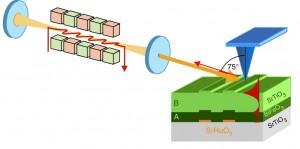Scientists at the US Department of Energy’s Lawrence Berkeley National Laboratory have developed a superlens from perovskite oxides. Unlike traditional metamaterial-based superlenses, perovskite-based superlens is easy and simple to produce.
Additionally, light can be captured by the superlens in the mid-infrared range and hence could offer potential uses in biomedical imaging and detection. Metamaterials-based superlenses are not well-suited for imaging since they would absorb the majority of photons required for the process.
 Experimental setup illustrates an IR free-electron laser light source and perovskite superlens
Experimental setup illustrates an IR free-electron laser light source and perovskite superlens
Heading the research at Berkeley Lab, materials scientist, Ramamoorthy Ramesh stated that unlike metamaterial-based superlens, the perovskite-based superlens reconstructs evanescent fields and does not focus propagating waves, thus generating sub-wavelength images that can be examined using near-field infrared microscopy. Further research has shown that the new superlens can achieve an imaging resolution of 1 µm.
Strontium titanate and bismuth ferrite are the perovskites used by the researchers. Featuring low absorption rate of photons, they can be developed as crystalline epitaxial multi-layers, which help reduce the number of lost photons by reducing interface roughness. Combining scattering losses and low absorption properties enables the superlens to provide better image resolution.
The properties of perovskites include piezoelectricity, ferroelectricity, magnetoresistance and superconductivity, making it ideal for use in nanoelectronics. The option to selectively use the superlensing effect makes it suitable for use in dense data storage applications.
Ramesh has authored the paper titled Near-field examination of perovskite-based superlenses and superlens-enhanced probe-object coupling, which was published in the journal “Nature Communications”.